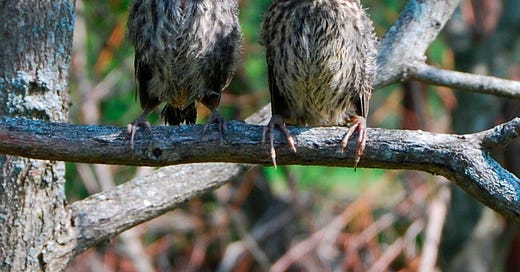The local red-wing blackbirds have a tendency to build their nest in branches that hang over the water’s edge. For many years, I have watched them build and raise young in the willow trees that grow on the bank surrounding the water. Typically, the males start singing in March, but this year, I have yet to hear their song.
One spring, many years ago, I was dressed for work, enjoying the last of my coffee on the porch. I spied ripples on the otherwise smooth waters and realized it was learn-to-fly day for the young, two of them ending up in the water instead, their waterlogged wings too heavy for flight.
Once I realized what was happening, I remembered Oscar, the giant snapping turtle who resides in our lake in the summer — Oscar, who can grab a duckling from below for lunch without ever rippling the water.
I spring into action, darting off the porch, down to the water’s edge, shoving off in the canoe to the rescue. As I neared the small birds, they grew even more agitated and frightened, one of them entirely exhausted and barely alive. I lifted them out of the water using the canoe oar and laid them in the bottom of the boat.
Once back on land, I grasped them with my hands and gently set them on a branch of the sassafrass tree. When they had regained some energy, they began calling their parents — who arrived almost immediately. All that summer, and the next, and the next, the red-winged blackbirds visited regularly and sang to me from that tree. I cannot say if they were the same birds I rescued, but I like to think so.
The two redwing young, after being rescued from the water.
Red-winged blackbirds are among the earliest migrating birds to return in spring. The males are natural show-offs, with their flashy red-and-yellow wing patches (called epaulets) and loud, persistent song. The blackbird’s distinct konk-la-reee, with its extended ending trill, is not the loveliest birdsong, but it is certainly most welcome this time of year.
I think of redwings as the true harbingers of spring. Males return from wintering ranges to claim territories in wetland marshes before the females return. Their early spring appearance has led some to believe their presence is a message that we are releasing past obstacles and restrictions in our lives and our beliefs. Others believe redwings are a positive omen meaning you need to draw from your inner self. For me, this song is a message that we are past winter, and spring has come.
Until it takes flight, the male can be mistaken for a common blackbird. It’s not until it takes off do we catch the tell-tale flash of crimson on the wing. Male red-winged blackbirds are more colorful and more vocal than females, most vocal during early spring mornings singing an average of 10 songs a minute. One male can have 15 different females making up its nesting territory.
Females are brown and heavily streaked, not black and red. They often lay three or four pale blue-green eggs, accented with black, brown, and purple markings. Red-winged blackbirds communicate using calls, screeches, and song singing. They can also communicate using body language and pheromones.
I await the return of the Red-Winged Blackbird as a sign that spring has also arrived. My joy at their appearance and the sound of their song may seem simple, and silly, but this is a reflection of my connection to the land and world around me.
What, for you, is a sure sign of spring? Who are your “neighbors in nature?”
Feel free to respond via comment, or via email. You can also share this post.



